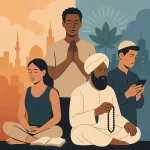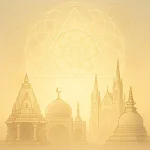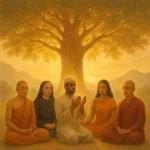Modern Faith and Practice: The Evolving Face of Spirituality in a Changing World
Faith has always been the guiding light of human civilization. From ancient rituals and temples to modern meditation apps and virtual congregations, the ways in which people connect with the divine have evolved dramatically. Yet the essence of faith—trust, hope, and surrender—remains timeless. In today’s fast-changing, technology-driven world, spirituality is no longer confined to traditional forms of worship. Modern faith and practice represent a blending of the old and the new, where personal experience often takes precedence over rigid doctrine.
The Shifting Landscape of Belief
In the past, religion was a collective experience—families and communities gathered in temples, churches, mosques, and gurudwaras. Faith was inherited, and rituals were followed as sacred duties. Today, however, faith has become more personal and self-directed. Many people identify as “spiritual but not religious,” seeking meaning without belonging to any organized faith. This reflects a global shift from institutional religion toward individualized spirituality.
Modern believers question more, explore more, and combine diverse teachings. A person might practice yoga inspired by Hindu philosophy, meditate using Buddhist techniques, and read the Bible for inspiration—all without feeling any contradiction. This blending of practices is not a rejection of tradition but a reimagining of it for contemporary life.
Technology and the Digital Sacred
In the 21st century, faith has entered the digital realm. Religious leaders now stream sermons online, devotees attend virtual festivals, and apps guide users through daily prayers or mindfulness sessions. The smartphone has become a modern shrine—a space where one can read sacred texts, chant mantras, or join live meditations with people across the globe.
This digital transformation has made spirituality more accessible. A person in a remote village can listen to spiritual talks by global teachers. Online communities allow people to share faith experiences, seek guidance, or simply feel less alone in their spiritual journey. However, it also poses new challenges. The commercialization of spirituality—through paid apps, courses, and influencers—can dilute the essence of genuine faith, turning it into a lifestyle trend rather than a path of self-discovery.
Mindfulness, Meditation, and Inner Faith
One of the most striking features of modern spirituality is the rise of mindfulness and meditation. Once confined to monasteries and ashrams, these practices are now part of daily life for millions. Corporations encourage employees to meditate for better focus, schools teach mindfulness to reduce stress, and psychologists use it as a therapeutic tool.
This new form of spiritual practice is less about worshiping an external deity and more about connecting with the divine within. It encourages awareness, compassion, and emotional balance. By quieting the noise of the outside world, modern seekers find answers within themselves—echoing ancient wisdom that the temple of God lies in the human heart.
Interfaith Harmony and Global Spirituality
Modern faith also embraces inclusivity. In an interconnected world, people are more exposed to multiple religions and philosophies. Interfaith dialogues, spiritual festivals, and multicultural gatherings encourage respect and learning across belief systems. The emphasis is shifting from “my religion is right” to “all paths lead to truth.”
This approach reflects the universal spirit behind all faiths—love, compassion, and peace. In an age of conflict and division, modern spirituality is becoming a unifying force, reminding humanity of shared values. Many young people today see themselves not as followers of one religion, but as seekers of wisdom from many traditions.
Science Meets Spirituality
Another hallmark of modern faith is its dialogue with science. Once seen as opposites, science and spirituality now complement each other. Neuroscientists study meditation’s effect on the brain, psychologists explore the role of prayer in healing, and quantum physicists question the nature of consciousness.
This convergence shows that faith and reason are not enemies—they are partners in the search for truth. Modern spiritual practitioners often combine ancient disciplines like yoga with evidence-based wellness approaches, bridging the gap between inner and outer worlds.
Challenges of Modern Faith
Despite its evolution, modern spirituality faces unique challenges. The fast pace of life leaves little room for reflection. Many people struggle with “spiritual burnout,” hopping between practices without depth or commitment. The abundance of online content can also cause confusion, as seekers encounter conflicting philosophies and commercialized teachings.
Moreover, the shift toward individual spirituality sometimes weakens the sense of community that traditional religions provided. Temples, churches, and mosques once served as places of belonging and moral guidance—roles that digital spirituality cannot always replace.
The Way Forward: Balance Between Tradition and Transformation
The future of faith lies in balance—honoring ancient wisdom while embracing modern understanding. Practices such as prayer, service, and meditation will remain timeless, but their forms will adapt to new generations and technologies. Modern faith invites individuals to live consciously—to blend devotion with daily life, to see divinity not just in rituals but in relationships, nature, and work.
Ultimately, the evolution of faith is a reflection of the evolution of humanity itself. As our world grows more complex, our spirituality becomes more inclusive and introspective. Modern faith does not demand blind belief; it encourages awareness, compassion, and authenticity. It reminds us that while the language of prayer may change, the longing behind it—the human desire for peace, connection, and purpose—remains eternal.
In this way, modern faith and practice are not a departure from the sacred past, but a continuation of it—a living, breathing spirituality that evolves with time, yet always leads us back to the timeless truth within.
~Religion World Bureau









